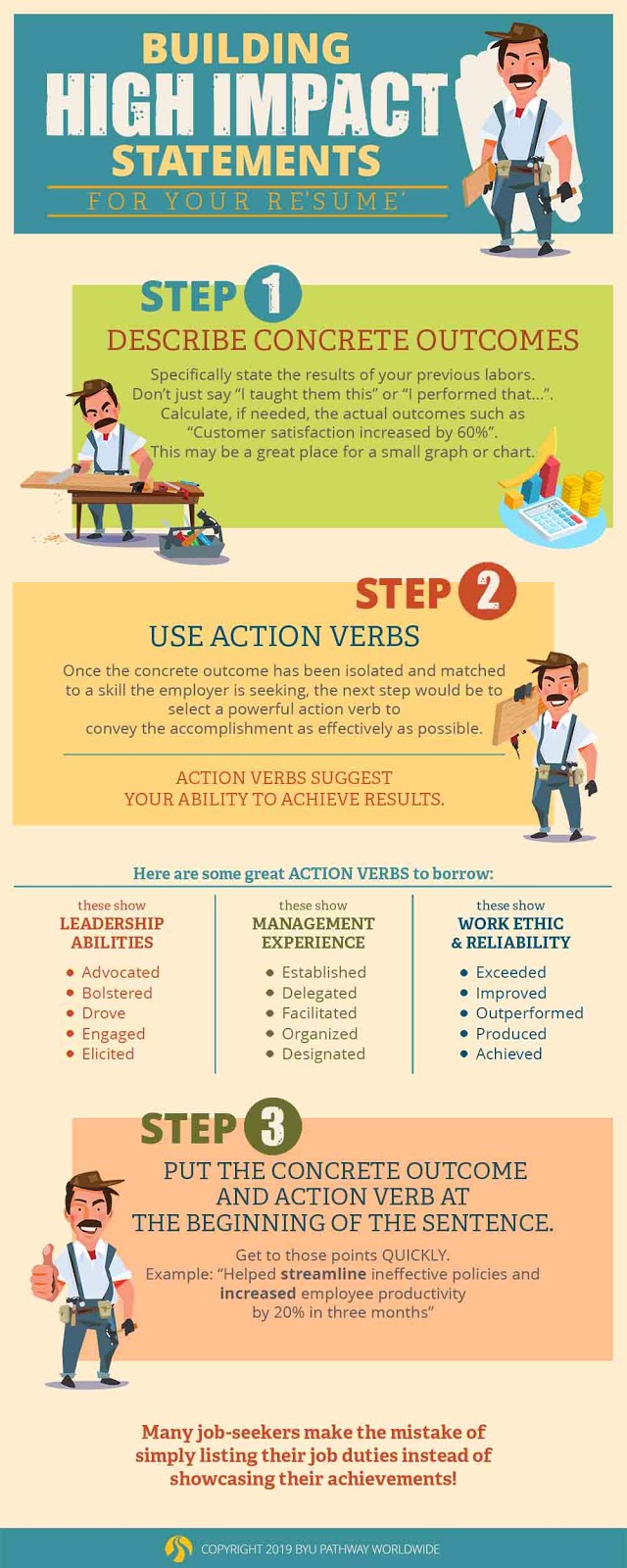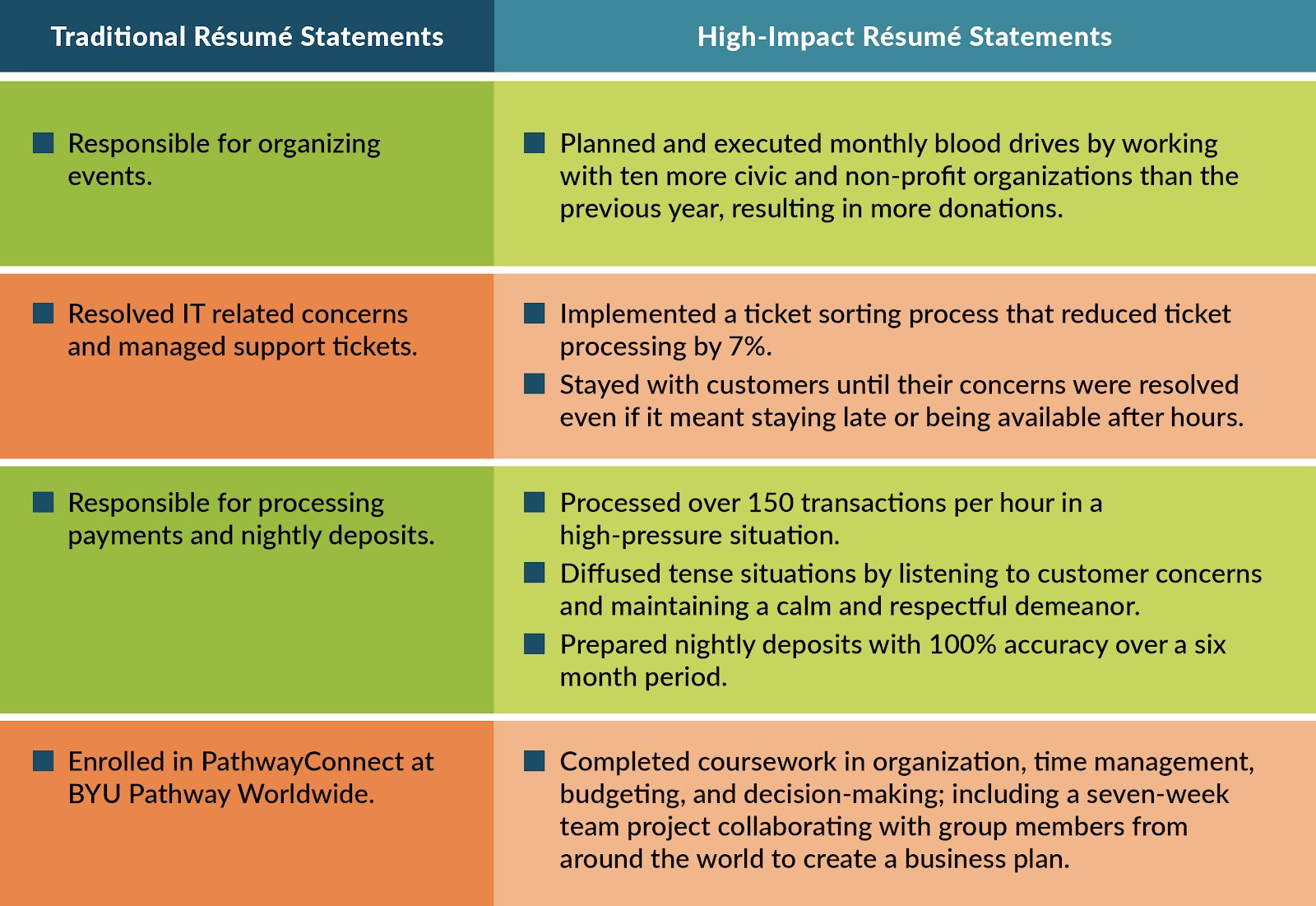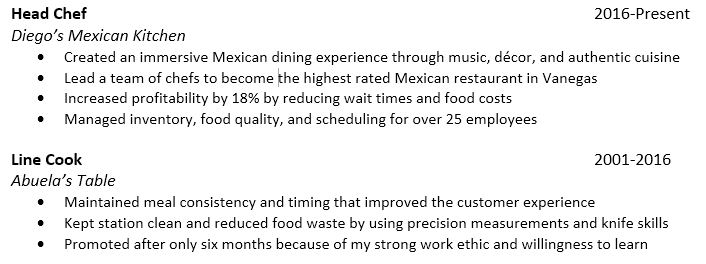Résumé
Experience Section
Hiring managers tend to view the “Experience” section as one of the most important parts of the résumé. And yet, many job seekers make the mistake of simply listing their job duties instead of showcasing their achievements. As Donna Svei, an executive résumé writer cautions, “You don’t want your résumé to read like a job posting” (5 Critical Parts of a Résumé). Potential employers are not very interested in what you did day-to-day at your job. However, they are very interested in what you accomplished there. More specifically, they’re interested in what you could accomplish at their company if you are hired.
To help you demonstrate what you can accomplish for an employer, this part of the lesson will focus on teaching you a resume writing technique called “high-impact statements.” A high-impact statement is a way of writing that demonstrates (or shows) what you can do rather than simply listing your job duties. To illustrate the difference, consider the more common "list of job duties" resume bullet point below:
- Trained new employees on how to run the front desk.
In this example, the person is stating what their job was - not how they did it or what the result was. Remember, employers don't want to know what you did; they want to know how you can help them.
Consider what this same bullet point would look like as a high-impact statement:
- Implemented an employee training program that increased customer satisfaction by 14% and reduced processing errors by 38%.
If you were a hiring manager, which one of these two statements would you be the most impressed with? The second one is obviously better because it demonstrates the results of their efforts and as a result, how they can help their potential employer implement similar measures.
Not only are high-impact statements a more effective way to communicate your abilities, but they can help you overcome the fear that you don’t have anything to offer. They do this by switching your mindset from “experience = job duties” to thinking about what you can offer an employer and how you can demonstrate that based on your experience (be it from work, home, church, or school).
To create a high-impact statement, you need to identify what specific achievements and experience you should include based on your analysis of your job posting.
Ponder and Record
- To start the brainstorming process, set a timer for five minutes and start writing down your accomplishments from your most recent position, project, calling, class, etc. Write down any accomplishment, contribution, or achievement that comes to mind, even if it seems insignificant. To help stimulate your memory, consider asking yourself the following questions:
- Did you receive praise or recognition from a supervisor or colleague? What was it for (i.e. completing projects before the deadline, calming down frustrated customers, saving money, etc.)?
- Did you receive a promotion, award, or recognition from customers/clients?
- Were you selected for special projects, committees, or task forces?
- Name three accomplishments that make you proud. Did you complete a particularly challenging assignment? Did you participate in a solution that improved customer service, enhanced efficiency, saved money/time, or increased revenues?
- What kind of reputation do you have?
Once you have completed the brainstorming process and aligned your specific achievements to the keywords, phrases, and values presented on the job posting description, you’re ready to turn those accomplishments into high-impact statements.
Creating High-Impact Statements
The following graphic illustrates the three things high-impact statements need to be effective.

Example
Let’s take a closer look at creating these high-impact statements by returning to the example of Sarah applying for the Student Services position at BYU-Pathway Worldwide. Imagine for a moment, that Sarah’s brainstorming activity produced the following accomplishments:
When I first started, morale was really bad. The turnover rate was high and the output quality was horrible. I suggested that the franchise manager make some minor adjustments to a few policies and perhaps start selecting an “employee of the month” for recognition, and I saw an immediate improvement.
Using the three-tiered formula above, how might this applicant turn this accomplishment into a high-impact statement?
Concrete Outcomes
A good place to start would be to ask the question, “what was the concrete outcome of this experience?” or “what skills or qualities do you want to demonstrate?”
Sarah said that there was an “immediate improvement.” What does that mean though? What was improved? By how much? A good next step would be for this applicant to do some pondering and perhaps even calculating to interpret what concrete outcomes came as a result of these minor adjustments (i.e. productivity improved by 20% and employee retention increased by 50% compared to the previous year).
Action Verbs & Placement
The next step is to select a powerful action verb to convey the accomplishment as effectively as possible.
If Sarah wanted to draw attention to her ability to be productive and to reduce inner conflict, she might create a couple of high-impact statements that look something like this:
- Helped improve ineffective policies and increase employee productivity by 20% in three months
- Advocated for a simple monthly rewards-based program that increased morale and employee retention by 50% over the previous year at minimal cost to the company
Did you notice that the action verbs were placed at the beginning of the statement showing her ability to achieve results?
In the chart below, note how traditional resume statements can be transformed into high-impact statements. Also note that if percentages or other quantitative data are not available, it is still possible to show impact.

Ponder and Record
Did you notice the power statement elements?
Which version do you think demonstrates to an employer, how you can make a difference at their company?
Look through the following examples, and see if you can identify the three elements of a high-impact statement.
Experience Section Formatting
Now that you’re in the mindset of using high-impact statements to show how you can add value to an employer, let’s look at how you will format this section. To start with, you should list your experience in reverse chronological order, meaning that you start with your most recent work experience and then go back in time as you add more experience. Be sure to include the date next to your experience so that employers can follow the timeline. Emphasize your experience by putting your title first, followed by the organization, and then add your high-impact bullet points. Remember that there are many different approaches to résumés, but for this class, your experience section should look like the example below.

As you can see, we’ll be using bullet points to create high-impact statements. When you use bullet points, it is very important that you use what is called “parallel structure.” Parallel structure is a way to show your reader that two (or more) ideas have the same importance. Using parallel structure also makes your writing smooth and easy to read. To create a parallel structure, you must present ideas in the same grammatical structure. Did you notice that all of the bullet points in the example above are past tense? If you switch between present tense, past tense, etc. it makes it hard to read. Another easy way to make sure you have a parallel structure is to start your bullet point with your action verb.
Tip: Work Experience

Did you notice the power statement elements?
Which version do you think demonstrates to an employer, how you can make a difference at their company?
Look through the following examples, and see if you can identify the three elements of a high-impact statement.